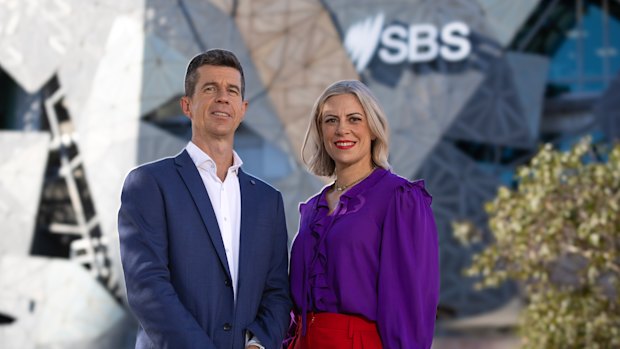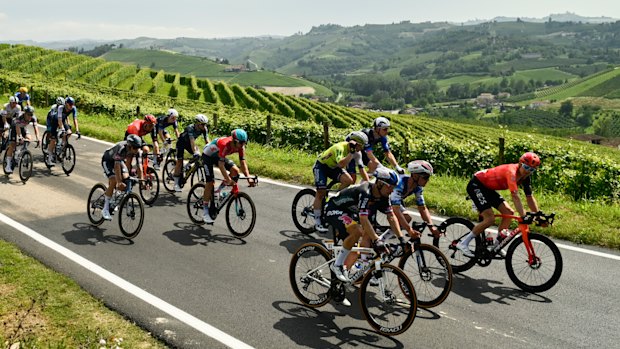‘Bigger than Beyoncé, Lady Gaga and Taylor Swift’: How SBS takes on the Tour de France
By Garry Maddox
It’s time to start spending late night after late night in front of the TV again. Time to watch cyclists riding freakishly fast through stunning French landscapes in the world’s greatest bike race – the Tour de France.
Assuming they all make the start fit and healthy, there will be plenty of interest this year in the showdown between the big three of “Pog”, “Jonas” and “Remco” – three-time winner Tadej Pogacar, two-time winner Jonas Vingegaard and reigning world and Olympic champion Remco Evenepoel.

A glorious celebration of cycling: Tadej Pogacar at the Tour de France last year.Credit: AP
“They’ll be in the best form of their lives,” says Dr Bridie O’Donnell, who is again part of the SBS commentary team for the Tour. “They’ll be at their race weight, they’ll have their seven teammates around them who have been specifically picked to support them. That for me is something bigger than Beyoncé, Lady Gaga and Taylor Swift playing for three weeks straight for free.”
For fans of elite sport on TV, the Tour is a glorious celebration of cycling every July.
This year’s men’s race starts in the northern city of Lille and covers 21 stages over more than 3300 kilometres. As always, expect sumptuous shots on the SBS coverage of vineyards, rivers, chateaux and mountains.
There is a new twist on the final stage of the Tour that will hold our interest until the final day – three climbs of the narrow, cobblestoned Montmartre hill that was so spectacular during the Paris Olympics. Tour director Christian Prudhomme has flagged the climb could lead to attacks if the race for the general classification is still close.

SBS Tour de France commentators Matthew Keenan and Bridie O’Donnell.Credit: SBS
The still-new women’s race – Tour de France Femmes – gets more intriguing every year. This time it starts in the Brittany town of Vannes and has been extended to nine stages over 1165 kilometres.
With two days overlap between the races, that’s 28 nights of SBS’s live coverage, supplemented with catch-up highlights on SBS On Demand the next morning.
The commentary team is led by Matthew Keenan, with insights and colour from O’Donnell, a former hour world record holder, and Simon Gerrans, who was the first Australian to win stages in all three grand tours. They will drive about 300 kilometres a day around France to be at the finish line of every stage.
“We spend a lot of time together – commentary box, dinner table, driving each day – so we get to know each other pretty well over the five weeks we’re on the road,” Keenan says.
Adds O’Donnell: “We share music playlists, we tell stories, sometimes we don’t talk and we definitely share the driving.”
The excitement around the Tour is evident in SBS’s coverage every year but having been lucky enough to watch the “grand depart” in Florence and the stage two finish in Bologna last year, I can report it’s just as colourful up close as on TV, the crowds are infectiously cheerful and the final sprint is stunningly fast.
For O’Donnell, seeing the excitement build in a new town every day is one of the best things about covering the Tour. “Even as we’re getting tired over the weeks, you see this whole new group of tens of thousands of people on the side of a mountain or in a beautiful village somewhere, and it just shows you what joy and excitement the event brings to the people in France,” she says.

Stunning French landscapes: riders on stage three of the Tour de France last year.Credit: Getty Images
So how are the races shaping up?
While crashes and illness can always affect riders’ chances, Keenan thinks Slovenia’s Pogacar and Denmark’s Vingegaard are equal favourites this year, with Belgium’s Evenepoel a slim hope after his third place last year.
There were some brilliant Australian performances at the Giro d’Italia in May and early June – stage wins for Kaden Groves, Luke Plapp and Chris Harper with Michael Storer finishing 10th – but Keenan nominates Ben O’Connor as Australia’s best chance at the Tour.
“He’s definitely a contender for the top five and a stage victory,” he says. “He’s going to be the rider that I’m sure we’re going to be talking about a lot, particularly when the race gets to the high mountains.”

Tour de France winner Katarzyna Niewiadoma wearing the overall leader’s yellow jersey last year.Credit: AP
Of the must-watch nights, stage seven is one of the most appealing.
“It goes to a place called Mur-de-Bretagne, where Cadel Evans won a stage in 2011 [on the way to winning the Tour],” Keenan says. “As an Aussie, we always like that one.”
Then there is Stage 13 – a mountain time trial. “It’s only 11 kilometres – that’s really short – but it goes to a climb called Peyragudes,” Keenan says. “For a race that’s more than 3000 kilometres, these 11 could be the most decisive.”
But of all the nights to watch, stage 16 should be particularly compelling, given it finishes on the mythical Mont Ventoux.
“Can you remember the edition where Chris Froome was off his bike and running?” Keenan says. “Richie Porte was off, [crashing into] the back of a motorbike, as well. The climb was shortened because of the wind at the top. Everything worked against that being a racing success and it was a day full of drama.”
The Tour de France Femmes has had a different winner every year so far – Holland’s Annemiek van Vleuten in 2022, Holland’s Demi Vollering in 2023 then Poland’s Katarzyna Niewiadoma last year.
O’Donnell believes new stars will emerge this time.
“The nine stages are all road stages – so no time trials – and an average of around 130 kilometres every day,” she says. “We’re going to see extraordinary women rising to the fore that we might not have heard of, like Puck Pieterse, the Dutch sensation who won a stage last year and the overall young rider’s jersey.”
Keenan thinks there are four or five big names in contention to win.
“The defending champion, Kasia Niewiadoma, [has] an Aussie, Neve Bradbury, as her key support rider and she’s not even considered third or even fourth favourite,” he says. “Demi Vollering has changed teams, so she’s now a big rival with her former key teammate Lotte Kopecky ...
“We’ve got the return of Anna van der Breggen, who was number one in the world when she retired four years ago and she was the mentor for Demi Vollering. And the French have got Pauline Ferrand-Prévot, who’s [also] a chance to win.”
Keenan believes the popularity of the Netflix series Tour de France Unchained, with its insights into team tactics and focus on personalities and drama, has done for cycling what Drive To Survive has done for Formula 1, despite criticism by some riders that it overstates tensions within teams.
“A lot of people look at cycling and see it as an individual sport if they haven’t followed it previously,” he says. “But when they watch Unchained and they go into the team bus and they see the team meetings where some riders are sacrificing their chances of getting a good result to help somebody else win, it really provides an education on the sport that makes it more enjoyable to watch.”
SBS’s coverage of the Tour de France runs from July 5-27 and the Tour de France Femmes from July 26-August 3, with daily highlights on SBS on Demand. Tour de France Unchained screens on Netflix from July 2.
Find out the next TV, streaming series and movies to add to your must-sees. Get The Watchlist delivered every Thursday.